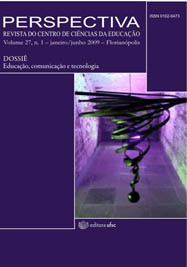Género, color/raza y niveles de letramento en Santa Catarina y Alagoas (Brasil): un experimento con base en micro-datos del censo del año 2000
DOI:
https://doi.org/10.5007/2175-795X.2009v27n1p249Resumen
A partir de los datos del Censo de 2000, el presente estudio se propone confrontar las relaciones de género, color y raza con los niveles de letramento en las provincias de Santa Catarina (SC) y
Alagoas (AL) Brasil, siendo estas provincias representativas de situaciones extremas del país en términos de educación
escolar. El estudio consideró apenas los jóvenes entre 18 y 24 años, que por su edad ya deberian/podrían haber fi nalizado la educación básica, que corresponde al nivel 4 de letramento.
Estos jóvenes fueron clasifi cados en diferentes niveles de letramento teniendo como base la cantidad de años cursados
y aprobados. Los resultados del análisis de la investigación son básicamente tres: primeramente, en cuanto en Santa Catarina predominan los niveles más elevados de letramento, en Alagoas
prevalecen los niveles más bajos, segundo, en ambas provincias, la situación de las mujeres está mejor que las de los hombres de cada provincia en términos de letramento, tercero, tanto en santa
Catarina como en Alagoas se verifi có la siguiente orden decreciente en relación al letramento: 1 – mujeres blancas,
2 – hombres blancos, 3 – mujeres negras, 4 – hombres negros, es decir, tenemos al mismo tiempo una superioridad de la mujer en relación al hombre y del color/raza blanca en relación a la negra. En síntesis al mismo tiempo en que se mantienen las históricas desigualdades regionales y de color/raza, las mujeres
jóvenes (de 18 a 24 años) representan mejores niveles de letramento que los hombres de la misma edad. El principal
desafío colocado por estos resultados está en la investigación y en el enfrentamiento político y pedagógico de las causas que, al mismo tiempo que llevan a la inversión de la relación de desigualdad en lo concerniente al género, mantiene y reproducen las desigualdades educacionales relacionadas con las variables
región y color/raza.
Descargas
Publicado
Cómo citar
Número
Sección
Licencia
Esta revista proporciona acesso público a todo seu conteúdo, seguindo o princípio de que tornar gratuito o acesso a pesquisas gera um maior intercâmbio global de conhecimento. Tal acesso está associado a um crescimento da leitura e citação do trabalho de um autor. Para maiores informações sobre esta abordagem, visite Public Knowledge Project, projeto que desenvolveu este sistema para melhorar a qualidade acadêmica e pública da pesquisa, distribuindo o Open Journal Sistem (OJS) assim como outros software de apoio ao sistema de publicação de acesso público a fontes acadêmicas. Os nomes e endereços de e-mail neste site serão usados exclusivamente para os propósitos da revista, não estando disponíveis para outros fins.
A Perspectiva permite que os autores retenham os direitos autorais sem restrições bem como os direitos de publicação. Caso o texto venha a ser publicado posteriormente em outro veículo, solicita-se aos autores informar que o mesmo foi originalmente publicado como artigo na revista Perspectiva, bem como citar as referências bibliográficas completas dessa publicação.



